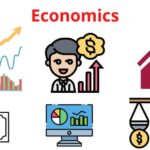Economics is a science that studies the production, distribution, and consumption of products and services. It looks into how individuals, corporations, and governments allocate resources to meet their demands and needs, as well as how these entities should organize and coordinate their activities to produce the best results.
The course is aimed to educate students abilities in identifying the forces that drive key economic trends and their influence on workers, corporations, and governments as part of their economics degree. Such abilities deal with scientifically analyzing economic facts, so offering a rationale for all economic difficulties, and, as a result, finding answers.
Two Important Branches of Economics
- Macroeconomics
- Microeconomics
Introduction to Macroeconomics
Macroeconomics is the area of economics that focuses on the overall structure of the economy and its performance rather than individual markets. National, regional, and global economies are all included. Gross domestic product, unemployment, and the price index are macroeconomic indicators. National income, output, consumption, unemployment, inflation, savings, investment, international commerce, and international finance are all rational aspects that macroeconomics aims to explain. Scarcity, choice, opportunity cost, production possibility curve, demand, supply, market equilibrium, comparative advantage, specialization, and exchange are all ideas in microeconomics.
Types of Macroeconomics Factors
- Inflation: Inflation determines an increase in the average cost of goods and services over a particular period.
- Interest Rates: The interest rate determines the amount earned by collaborating money within the country’s financial system.
- Fiscal Policy: Fiscal policy determines the flow of money in circulation within both sectors of the economy.
- GDP: GDP stands for Gross Domestic Product determines which determines the overall value of goods and services produced by a country.
- National income: The whole amount of money the country generates within the economy.
- Economic Growth Rate: This factor determines the change in the cost percentage of producing goods and services in a country during a certain time compared to the previous growth period.
Introduction to Microeconomics
Microeconomics is a broad and important branch of economics. Microeconomics is the study of how a person or a business organization makes decisions about how to allocate resources and trade commodities and services. A student might select from a variety of job options after completing proficiency in the field.
Theories of Microeconomics
- Consumer Demand Theory– The process of making decisions to spend money according to the needs and budget is considered as microeconomic.
- Production Theory– It is an effective and useful theory of microeconomics created by Jean-Baptiste Say. It works for tracking the money and time spent by a firm to sell goods and services. It also works to check the profit saved by a company through its goods and services.
- Price Theory– This theory of microeconomics includes the process of making decisions to decide the proper price or value of goods and services in an organization or business firm.
- Supply and Demand Theory– The process of communication between an organization and its customers regarding the sale and purchase of products and services is termed as the supply and demand theory of microeconomics.
- Opportunity Cost Theory– Opportunity costs theory determines the potential advantages that an individual, investor, or organization misses out on when choosing one choice over another.
Hence, it is difficult to understand these theories. Therefore, many students in Australia demand to do my assignment for me to avoid a negative impact on their academics and to understand subject-related knowledge.
What is the Difference between Macroeconomics and Microeconomics?
There are two essential branches of economics- macroeconomics and microeconomics. Macroeconomics is the wider branch of economics that deals with the economy of a country and tries to increase the living standards of all the citizens living in a country whereas, Microeconomics is the smaller branch of economics that works to make decisions to develop the economy of an individual or a business organization.
In comparison to macroeconomics, microeconomics is concerned with a narrow scope of research. Microeconomics is concerned with the behavior of individuals and small businesses in a single market, as well as decision-making processes and resource allocation.
Microeconomics studies the consequences of significant market participants’ decisions on the supply and demand for goods and services, which influences pricing and, ultimately, the quantities demanded and provided in the market.
It also looks at how national economic policies, such as changing tax rates, affect the demand and supply dynamics in the market.
What are the Best Career Opportunities Available for the Students of Macroeconomics?
Macroeconomics is considered as a vast and important branch of economics. Many students are studying this vast field to avail all its career opportunities. There are several career opportunities available for students of macroeconomics. Some of them are quoted below-
- Economist
- Macroeconomic Analyst
- Economic Advisor
- Macroeconomics Professor
What are the Best Career Opportunities Available for the Students of Microeconomics?
There are many different career scopes that students can opt for according to their own interests after learning and taking a degree in microeconomics. Some of those career options are mentioned below-
- Economists
- Microeconomics Lecturer
- Financial Risk Analyst
- Researcher of Economics
- Investment Analyst
Different Topics of Economics Assignment
- Cost and Production: Assignments on declining marginal productivity, Isoquant & Iso-cost, Cost minimization, and Profit maximization are common in this field.
- Market Structure: The most typical themes requested in writing economics assignments include market kinds such as monopoly, oligopoly, and oligopolistic competition, as well as different types of competition such as monopolistic or perfect competition.
- International Trade: Theories like the production possibility frontier, opportunity cost, comparative advantage, terms of trade, and gain from trade are frequently utilized in international trade assignments.
- Externality: Positive externality, negative externality, market failure, Pigouvian tax, and the Coase theorem are all examples of externality.
- GDP accounting: Here, Economics assignment writing service providers describe how to calculate GDP using methods such as spending, income, and value-added, while emphasizing the cyclical flow of revenue in an economy and the multiplier effect.
- AD-AS model: These are about macroeconomic ideas, which are one of the most significant branches of economics, such as full employment, output gap, fiscal policy, and monetary policy.
It is critical for economics students to be aware of all of these major microeconomic theories. These microeconomic theories can assist a student in pursuing a career as an economist. Economics is a lucrative topic of study that requires students to complete a variety of assignments. Therefore, many students seek Economics assignments help to avoid a negative impact on their academics.










